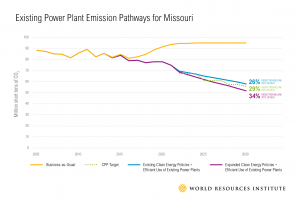Missouri can meet targets under the Clean Power Plan (CPP) through clean energy policies and better power plant efficiency according to an analysis from World Resources Institute. Under the CPP, the state has a mass-based emissions reduction target of 29 percent below 2012 levels by 2030. The analysis shows that if Missouri achieves its  current energy efficiency and renewable energy goals and makes more efficient use of its natural gas and coal fleet, the state can get 90 percent of the way towards its target. However, if Missouri expands its renewable energy standard, the state can exceed its target, achieving 34 percent reductions below 2012 levels by 2030.
current energy efficiency and renewable energy goals and makes more efficient use of its natural gas and coal fleet, the state can get 90 percent of the way towards its target. However, if Missouri expands its renewable energy standard, the state can exceed its target, achieving 34 percent reductions below 2012 levels by 2030.
“Missouri has already taken steps toward meeting its Clean Power Plan goals,” said Sam Adams, director, U.S. Climate Initiative, WRI. “Missouri’s energy efficiency and renewable energy policies are creating jobs and spurring in-state investment. If Missouri expands on the progress it’s already making on energy efficiency and renewable energy it can seize important economic opportunities while complying with the Clean Power Plan.”
The analysis finds that Missouri’s energy efficiency and renewable energy policies already benefit the state. For example:
- In 2014, the energy efficiency sector in Missouri employed 32,000 people, a number expected to grow if efficiency programs are expanded;
- According to the American Wind Energy Association, Missouri’s wind industry has generated $1.4 million in annual land lease payments and $1 billion in total capital investment as of 2014, in addition to employing 6,000 workers that year;
- Meeting the existing renewable energy standards could create 30,000 new jobs by 2021 and provide over $1 billion in new income to residents;
- According to analysis by the American Council for an Energy-Efficient Economy, new energy efficiency initiatives in Missouri, including utility programs and building codes, could save consumers $6.1 billion and create 8,500 new jobs.
- Currently, Missouri spends about $1.3 billion per year on importing coal from other states. By investing in efficiency and renewables, Missouri can reduce its imported coal consumption and keep more of its energy investments in-state.
“Missouri can come close to its Clean Power Plan emissions reductions target by following through on its renewable energy standard and voluntary energy efficiency goals and making smarter, more efficient use of fossil fuel power plants. And by expanding its renewable energy standard, the state can go even further,” said Rebecca Gasper, research analyst, WRI. “Missouri can use its existing clean energy policies to ensure the state continues toward a low carbon future while bringing economic benefits to its residents and businesses.”

